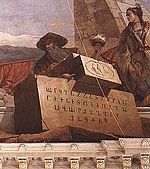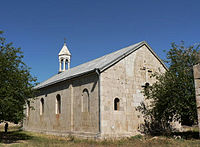Mesrop Mashtots
Mesrop Mashtots (ⓘ; Armenian: Մեսրոպ Մաշտոց Mesrop Maštoc'; Eastern Armenian: ; Western Armenian: ; 362 – February 17, 440 AD) was an Armenian linguist, composer, theologian, statesman, and hymnologist in the Sasanian Empire.
This article possibly contains original research. (December 2023) |
He is venerated as a saint in the Armenian Apostolic, Catholic, and Eastern Orthodox Churches.
Saint Mesrop Mashtots | |
|---|---|
 Portrait of Mashtots by Stepanos Nersissian (1882) | |
| Born | c. 362 Hatsik, Taron Province, Kingdom of Armenia (Now Güven village of Korkut, Muş Province, Turkey) |
| Died | February 17, 440 Vagharshapat, Sasanian Armenia |
| Venerated in | Armenian Apostolic Church Armenian Catholic Church Roman Catholic Church Eastern Orthodox Church |
| Major shrine | Saint Mesrop Mashtots Cathedral in Oshakan, Armenia |
| Feast | The Armenian Church remembers St. Mesrop (together with St. Sahak), twice each year, first in July and then again on the Feast of the Holy Translators in October; February 17 in the Roman Catholic Church. |
| Patronage | Armenia |
He is best known for inventing the Armenian alphabet c. 405 AD, which was a fundamental step in strengthening Armenian national identity. He is also considered to be the creator of the Caucasian Albanian and Georgian alphabets by a number of scholars.
Life
This section needs additional citations for verification. (December 2023) |


Mashtots was born in a noble family ("from the house of an azat" according to Anania Shirakatsi) in the settlement of Hatsekats in Taron(identified as the village of Hatsik in the Mush plain), and died in Vagharshapat. He was the son of a man named Vardan. Koryun, his pupil and biographer, writes that Mashtots received a good education and was versed in the Greek and Persian languages. On account of his piety and learning, Mesrop was appointed secretary to King Khosrov IV, in charge of writing royal decrees and edicts in Persian and Greek.
Leaving the court, Mashtots took the holy orders and withdrew to a monastery with a few companions, leading a life of great austerity for several years. In 394, with the blessing of Sahak Part'ev, Mashtots set out on a proselytizing mission. With the support of Prince Shampith, he preached the Gospel in the district of Goghtn near the river Araxes, converting many.

Encouraged by the patriarch and the king, Mesrop founded numerous schools in different parts of the country, in which the youth were taught the new alphabet. He himself taught at the Amaras monastery of the Armenian province of Artsakh (located in the contemporary Martuni region of the unrecognized Nagorno-Karabakh Republic).[citation needed] However, his activity was not confined to Eastern Armenia. Provided with letters from the Catholicos, he went to Constantinople and obtained from emperor Theodosius the Younger permission to preach and teach in his Armenian possessions. Having returned to Eastern Armenia to report to the patriarch, his first thought was to provide religious literature for his countrymen. He sent some of his numerous disciples to Edessa, Constantinople, Athens, Antioch, Alexandria, and other centers of learning, to study the Greek language and bring back the masterpieces of Greek literature. The most famous of his pupils were John of Egheghiatz, Joseph of Baghin, Yeznik, Koriun, Moses of Chorene, and John Mandakuni.

The first monument of Armenian literature is the version of the Holy Scriptures. Isaac, says Moses of Chorene, made a translation of the Bible from the Syriac text about 411. This work was considered imperfect, for soon afterwards John of Egheghiatz and Joseph of Baghin were sent to Edessa to translate the Scriptures. They journeyed as far as Constantinople and brought back authentic copies of the Greek text with them. With the help of other copies obtained from Alexandria, the Bible was translated again from the Greek according to the text of the Septuagint and Origen's Hexapla. This version, now in use in the Armenian Church, was completed about 434.

The decrees of the first three ecumenical councils — Nicæa, Constantinople, and Ephesus — and the national liturgy (so far written in Syriac) were also translated into Armenian, the latter being revised on the liturgy of St. Basil, though retaining characteristics of its own. Many works of the Greek Fathers were also translated into Armenian. The loss of the Greek originals has given some of those versions a special importance; thus, the second part of Eusebius's Chronicle, of which only a few fragments exist in Greek, has been preserved entirely in Armenian. In the midst of his literary labors, Mashtots revisited the districts he had evangelized in his earlier years, and, after the death of Isaac in 439, looked after the spiritual administration of the patriarchate. He survived his friend and master by only six months. Armenians read his name in the Canon of the Liturgy and celebrate his memory on 19 February.
Mashtots is buried at a chapel in Oshakan, a historical village 8 km (5.0 miles) southwest from the town of Ashtarak. He is listed officially in the Roman Martyrology of the Roman Catholic Church; his feast day is February 17.
Alphabet

Armenia lost its independence in 387 and was divided between the Byzantine Empire and Persia, which received about four-fifths of its territory. Western Armenia was governed by Byzantine generals, while an Armenian king ruled as Persian vassal over eastern Armenia. The principal events of this period are the invention of the Armenian alphabet, the revision of the liturgy, the creation of an ecclesiastical and national literature, and the revision of hierarchical relations. Three men are prominently associated with this work: Mashtots, Part'ev, and King Vramshapuh, who succeeded his brother Khosrov IV in 389.
Armenians probably had an alphabet of their own, as historical writers reference an "Armenian alphabet" before Mashtots, but used Greek, Persian, and Syriac scripts to translate Christian texts, none of which was well suited for representing the many complex sounds of their native tongue. The Holy Scriptures and the liturgy were, to a large extent, unintelligible to the faithful and required the intervention of translators and interpreters.
Mashtots was assisted in inventing an Armenian writing system by Sahak and Vramshapuh. He consulted Daniel, a bishop of Mesopotamia, and Rufinus, a monk of Samosata, on the matter and created an alphabet of thirty-six letters; two more (long O (Օ, օ) and F (Ֆ, ֆ)) were added in the twelfth century.
The first sentence in Armenian written down by Mesrop after he invented the letters was the opening line of Solomon's Book of Proverbs:
Ճանաչել զիմաստութիւն եւ զխրատ, իմանալ զբանս հանճարոյ:
Čanačʿel zimastutʿiwn ew zxrat, imanal zbans hančaroy.
«To know wisdom and instruction; to perceive the words of understanding.»— Book of Proverbs, 1:2.
The invention of the alphabet around 405 was crucial for Armenian literature and was significant in the creation of a separate idea of Armenian language and what was connected to it. "The result of the work of Isaac and Mesrop", says St. Martin, "was to separate for ever the Armenians from the other peoples of the East, to make of them a distinct nation, and to strengthen them in the Christian Faith by forbidding or rendering profane all the foreign alphabetic scripts which were employed for transcribing the books of the heathens and of the followers of Zoroaster. To Mesrop we owe the preservation of the language and literature of Armenia; but for his work, the people would have been absorbed by the Persians and Syrians, and would have disappeared like so many nations of the East".
Medieval Armenian sources also claim that Mashtots invented the Georgian and Caucasian Albanian alphabets around the same time. Most scholars link the creation of the Georgian script to the process of Christianization of Iberia, a core Georgian kingdom of Kartli. The alphabet was therefore most probably created between the conversion of Iberia under King Mirian III (326 or 337) and the Bir el Qutt inscriptions of 430, contemporaneously with the Armenian alphabet.
Legacy

Virtually every town in Armenia has a street named after Mashtots. In Yerevan, Mashtots Avenue is one of the most important in the city center, which was previously known as Lenin Avenue. There is a statue of him at the Matenadaran, one at the church he was buried at in Oshakan village, and one at the monument to the Armenian alphabet found on the skirts of Mt. Aragats, north of Ohanavan Village. Stamps have been issued with his image by both the Soviet Union and by post-Soviet Armenia.
The Order of St. Mesrop Mashtots, established in 1993, is awarded for significant achievements in economic development of the Republic of Armenia or for accomplishments in science, culture, education or public service, and for activities promoting those fields.
Music
Mashtots also produced a number of liturgical compositions. Some of the works attributed to him are: «Մեղայ քեզ Տէր» (Meġay k’ez Tēr, “I have sinned against you, Lord”), «Ողորմեա ինձ Աստուած» (Voġormea inj Astuac, “Have mercy on me, God”), «Անկանիմ առաջի քո» (Ankanim aṙaǰi k’o, “I kneel before you”) and «Ողորմեա» (Voġormea, “Miserere”), all of which are hymns of repentance.[citation needed]
Documentary films
- Mashtots (1988), directed by Levon Mkrtchyan
See also
References
Bibliography
- Yuzbašyan, Karen (2011). "L'invention de l'alphabet arménien". Revue des Études Arméniennes. 33: 67–129. doi:10.2143/REA.33.0.2144981.
- Yuzbašyan, Karen (1995). "Le destin de l'alphabet de Daniēl en Arménie". Revue des Études Arméniennes. 25: 171–181. doi:10.2143/REA.25.0.2003780.
- Markwart, Josef (1917). Ueber den Ursprung des armenischen Alphabets in Verbindung mit der Biographie des heil. Maštocʻ. Vienna: Mechitharisten-Buchdruckerei.
- Feydit, Frédéric (1964). Considérations sur l'alphabet de Saint Mesrop. Vienna: Mechitharisten-Buchdruckerei. OCLC 460351913.
- Ačaṙean, Hračʿya (1984). Հայոց գրերը [The Armenian alphabet] (2 ed.). Yerevan University Press.
- Winkler, Gabriele (1994). Koriwns Biographie des Mesrop Maštocʻ : Übersetzung und Kommentar. Rome: Pontificio istituto orientale. ISBN 9788872102985.
- Attribution
 This article incorporates text from a publication now in the public domain: Vaschalde, A. A. (1911). "Mesrob". In Herbermann, Charles (ed.). Catholic Encyclopedia. Vol. 10. New York: Robert Appleton Company.
This article incorporates text from a publication now in the public domain: Vaschalde, A. A. (1911). "Mesrob". In Herbermann, Charles (ed.). Catholic Encyclopedia. Vol. 10. New York: Robert Appleton Company.
External links


This article uses material from the Wikipedia English article Mesrop Mashtots, which is released under the Creative Commons Attribution-ShareAlike 3.0 license ("CC BY-SA 3.0"); additional terms may apply (view authors). Content is available under CC BY-SA 4.0 unless otherwise noted. Images, videos and audio are available under their respective licenses.
®Wikipedia is a registered trademark of the Wiki Foundation, Inc. Wiki English (DUHOCTRUNGQUOC.VN) is an independent company and has no affiliation with Wiki Foundation.
